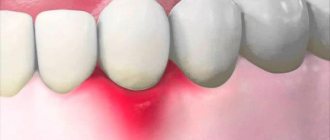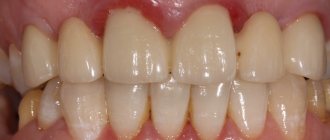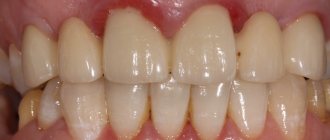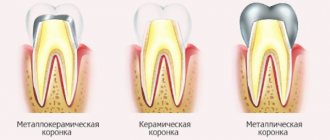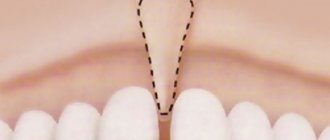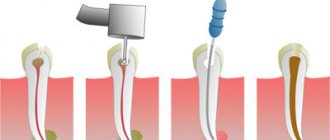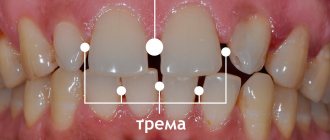Problem: For about five years, a man suffered from food getting between his teeth. Food getting stuck meant that I constantly had to pick between my teeth to remove food debris and my gums became inflamed. Friends advised me to contact Dial-Dent to eliminate the gap between my teeth.
Solution: old crowns on the teeth were replaced (the crowns were more than 5 years old, they were done in another clinic). Using computer modeling, tight contacts between teeth were created and the anatomical shape of the chewing surface was restored. Now food does not get between the teeth, it is chewed better, and the gums do not hurt. With new ceramic crowns from Dial-Dent, the problem is completely solved.
Choosing treatment tactics for food stuck between teeth
At the consultation, orthopedic dentist S.V. Zukor discovered that between the chewing teeth on the lower jaw there is a gap where food gets clogged. Due to food getting stuck between the teeth, the gums are constantly pressed, and the use of various improvised means for picking between the teeth injures the gums even more, so the gums hurt. The teeth have crowns that do not have the correct shape, there is no close contact between the teeth, and the chewing surfaces are almost flat.
To eliminate food getting between the teeth, the dentist suggested replacing the old crowns and making new ones with tight contact so that there is no gap between the teeth.
Causes
There are many reasons why food gets stuck between teeth over and over again:
- incorrectly recreated contact points in the treatment of caries,
- low-quality artificial crown or cement residues after its fixation,
- abundant supra- and subgingival deposits,
- malocclusion.
And if the other reasons for the problematic situation are, in general, clear, then how an incorrect bite can affect food getting stuck is not obvious. Let's look at this in more detail.
Normally, the crown parts of adjacent teeth should be in close contact with each other. The places of their contact are called contact points. It is these that are so important to restore when filling a carious cavity, so that caries does not occur again in the same place. The condition of the periodontal papilla, the area of gum in the interdental space necessary to protect the neck of the tooth and the interalveolar septum, also depends on the quality of the contact points.
If the papilla disappears, food will begin to get trapped under the gum and then the roots of the teeth will deteriorate. In addition, when food gets stuck between the teeth and puts pressure on the interdental papilla, pain occurs, and the decomposition of food debris contributes to the appearance of bad breath, the development of inflammation, which ultimately can lead to consequences such as periodontitis and premature tooth loss.
Incorrect posture, the habit of holding your head low, scoliosis or any other spinal deformity causes overstrain of the neck muscles, which in turn leads to asymmetrical spasm of some and relaxation of other facial muscles. Prolonged stay in this state causes an imbalance in the facial-masticatory muscles, which ultimately leads to a change in the position of the teeth.
This process occurs slowly and often goes unnoticed. But over time, some people may experience crowding, while others, on the contrary, may have teeth that diverge. In this case, some teeth may change their position relative to the vertical axis. All these factors lead to the formation of malocclusion. Wide dental spaces or, conversely, narrow ones, are the places where food gets stuck between the teeth. Thus, it turns out that postural disturbances can cause food to accumulate between the teeth.
Dental scanning and dental crown modeling
Before modeling the new crowns, a teeth scan was performed. Dental scanning replaces traditional dental impressions, which many patients cannot tolerate due to an increased gag reflex. When taking digital impressions of teeth, the dentist runs a Sirona scanner along the surfaces of the teeth for several minutes, and a three-dimensional image of both jaws is transferred to the computer - a digital impression of the teeth.
Working with a digital impression in a specialized program, the dentist models crowns with the most tight contacts between the teeth and the correct anatomical chewing surface.
Based on the simulation results, the dental technician produced ceramic crowns from E.max ceramics. Pressed ceramics E.max has high strength and excellent aesthetic properties, therefore it is used for prosthetics of both lateral and anterior teeth.
Why does food end up between teeth?
In dentistry, there is the concept of a contact point. This is the name given to the point of contact between the lateral surfaces of two adjacent teeth. The function of the contact point is to protect the gingival papilla from injury from pieces of chewed food. The papilla itself protects the interdental space from food entering there. Therefore, when the contact point is destroyed, problems begin.
This problem can arise for various reasons:
- due to poor-quality treatment of caries and incorrectly placed fillings - for example, when the anatomical relief of the tooth being restored is not accurately reproduced;
- in case of poor-quality dental prosthetics - with the formation of an overhanging edge of the crown, with its contour being too wide, due to cement remaining on the surface after fixing the crown, or due to an incorrectly designed hanging part of the bridge.
But the anomaly is not always caused by dental errors. Very often, food gets stuck in people with disturbances in the natural structure of the dentition: with crooked, tilted and crowded teeth, with a diastema - a gap between the upper or lower incisors, or with trema - gaps between the lateral teeth.
In addition, food remains in carious cavities and in interdental spaces formed after injuries and professional tooth extraction. Tartar formed above and below the gum also contributes to the sticking of pieces, which provokes the development of periodontal diseases.
The result of replacing crowns is that food does not get stuck between the teeth
Tight contacts between teeth ensure that food does not get stuck and gums remain healthy.
The cost of ceramic crowns is 55,000 rubles per unit.
Of course, it is possible to make dental crowns cheaper (cheaper material, lack of computer modeling, etc.), but this will invariably affect the quality. The use of computer technology makes it possible to more carefully work out the shape of the crowns, provides additional convenience when taking impressions - all this is reflected in the price, so good dental crowns cannot be cheap. In addition, Dial-Dent uses the highest quality and most modern materials both for the crowns themselves and for their fixation, which increases the service life of dental restorations.
Video about how teeth are scanned with an intraoral scanner:
What causes food getting stuck in teeth?
As a rule, those patients who become annoyed by the need to constantly remove food debris turn to a dentist for advice. They can be understood: over time, this procedure begins to take more and more time. Many people also note the appearance of bad breath. But these are only the very first signs of an unresolved and therefore progressive problem.
- By injuring the gingival tissue, food debris over time causes chronic inflammation, which is invisible to the patient due to its sluggish nature.
- Constant use of toothpicks and floss aggravates inflammation, transforming it into gingivitis and periodontitis. In the absence of treatment, in addition to the unpleasant odor, the patient will sooner or later be faced first with exposure of the tooth roots, and over time with loosening and premature loss of the teeth themselves. This is explained by the gradual resorption of the bone interdental septa adjacent to the source of inflammation.
- Poorly cleaned dental spaces become a breeding ground for pathogenic microflora that affects the contact surfaces of the teeth. Caries in these places is difficult to recognize at the initial stage and often manifests itself as severe pain already at the stage of development of pulpitis.
How to maintain healthy teeth and gums for a long time and extend the life of dental crowns
The dentist said that to maintain healthy teeth and gums, it is necessary to undergo professional teeth cleaning at least once every six months. Dial-Dent understands the importance of prevention and oral hygiene, so they have developed the “Teeth for Life” program. Professional oral hygiene helps remove plaque not only from your teeth, but also from crowns, veneers, implants, thereby extending their service life, and prevents the occurrence of caries, periodontitis and other diseases.
See other examples of the work of Family Dental specialists here.
Make an appointment for a consultation by phone +7-499-110-18-04 or through the form on the website. You can ask questions about dental prosthetics to the chief doctor of the clinic, Sergei Vladimirovich Tsukor, at
Causes of pain in the gums
Unpleasant sensations in soft tissues can be temporary or permanent. Most often pain occurs:
- due to damage to the gums by hard food, bone, toothpick,
- using a toothbrush with stiff bristles,
- untimely removal of soft plaque,
- consuming hot foods and drinks,
- allergies to mouthwash components,
- deficiency of vitamins and minerals in the body.
When the mucous membrane is injured, the pain goes away within 2-4 days. Also, sometimes it is enough to change the brush to a softer one, buy another toothpaste and rinse to get rid of discomfort in the oral cavity.
Why does a tooth hurt when you press it?
Toothache is one of the most unpleasant. At the same time, the variety of sensations that bad teeth can “delight” us with is enormous, as are the reasons that cause them.
Sometimes pain does not arise from chemical or temperature influences, as often happens, but from pressure on the tooth - with the tongue, fingers, or when chewing food.
Many believe that there can only be one cause of this pain, but experts talk about various factors that can cause pain and severe discomfort when pressing on a tooth.
However, even an experienced dentist, without a thorough examination and interview of the patient, as well as conducting some research, will not be able to assess the situation unambiguously.
The content of the article:
How is the problem corrected in the clinic?
The main thing in treatment is the correct formation of the contact point. A wide variety of matrix systems and filling materials will help to successfully treat caries. The filling must not only be placed, but also given the correct shape in order to achieve tight contact with the adjacent tooth. If the problem of food getting stuck is caused by an overhanging edge of the filling because the previous dentist gave it the wrong shape, then the filling will be changed. Dentures of unsatisfactory quality must be replaced. “Black triangles” and deep pockets are corrected by dental surgeons. There is no way around it without surgery. Teeth crowding, spasms and diastema can be corrected with orthodontic therapy. To eliminate these defects, it is better to use the method of aesthetic restoration of teeth with crowns, veneers and fillings. Tartar is removed using a special procedure using a professional method, followed by root polishing.
Veneers are microprostheses that restore the aesthetic appearance of teeth, allow you to choose the color and shape of one or a group of teeth, and eliminate interdental spaces.
Evina Nov 29, 2015
Good day,
I was so exhausted that I even decided to register on the forum, I really hope that you can help me. doctors.
2 weeks ago I went for an examination to a dentist, they told me that I had caries on the 5th upper tooth on the left (although I didn’t see it there, but the doctor knows better). They cleaned everything, removed the nerves, made a filling (not like shining a light bulb, but for some reason an ordinary one). After that, the tooth hurt very much for a week, it ached terribly. I called the doctor, came back again, they said the pain would go away, they checked me again and said that there was nothing to worry about, everything was fine. Another week has passed. Yes, now I don’t feel any pain, but there’s just a terrible feeling of unpleasant fullness in the tooth. There’s a constant feeling that something soft is stuck there. It’s as if there’s a hole in the tooth itself and everything in it is stuffed like paper. There is no pain, but this constant sensation is simply killing. It seems that the tooth is bursting from the inside and when closing the jaw there is such a soft but very unpleasant pressure on the gum. Like something superfluous. I always want to get it. I don’t know what to do, as it’s not convenient to get a doctor, she assures me that everything is fine, but the feeling is simply driving me crazy, the eternal feeling of something extra in the tooth. Maybe it’s worth filing down the filling or what do you think? Why could this be?
I'll attach a photo just in case.
A Quick Guide to Tooth Sensitivity
In our world filled with feelings, more and more scientific research is being conducted on the topic of sensitivity and emotions, and in recent decades the term “emotional intelligence” has even been coined. Moreover, a person who shows increased sensitivity is considered the most intelligent and cultured. On the other hand, when dealing with pain sensitivity, we all hope to find ourselves on the other side of the barricades. A dental clinic is one of those places where the main goal is to bring our lives back to normal and end our suffering.
Whether it’s pleasant or quite the opposite, pain plays a very important role in a living organism. Pain is, in essence, the guard dog of the body of any living creature, and its function is to signal danger and push to find ways to heal. We immediately associate thoughts about dentistry and dental problems with pain, but this is not always true. In some cases, if, for example, root canal treatment has already been performed on a tooth, the deterioration of the condition of this tooth and, therefore, the oral cavity may not be accompanied by any pain. Toothache is a very multifaceted phenomenon and can occur for various reasons and in different ways. The structure of the tooth consists of three main systems. The first layer that we are all familiar with is the layer of enamel called dentin. Beneath it is a layer of dental pulp, which is the living tissue of the tooth that contains blood vessels. In order for the teeth to remain in place and be strong, we need a third layer, the role of which is to fix and hold the teeth in the gum. This layer consists of the gum tissue that surrounds the tooth and the millions of fibers that attach the tooth to the jawbone. In essence, damage to each of these systems can result in dental pain of varying degrees and intensity, depending on the level of damage and the type of tissue damaged. There are many common cases of tooth sensitivity and pain that are caused by dental disease. But there are also cases in which the pain is in no way related to the development of caries, more popularly known as a hole in the tooth.
Possible diseases
Constant pain in the gums is one of the main symptoms of the following oral diseases.
- Gingivitis. Acute or chronic inflammation of the mucous membrane. Develops due to the accumulation of plaque. Soft deposits mineralize and turn into tartar, which cannot be removed with a regular brush. Pain occurs in the gums between the teeth.
- Periodontitis. Periodontal inflammation, in which the dentogingival joints are destroyed. Develops due to advanced gingivitis. The risk group includes patients with a hereditary predisposition to the disease.
- Stomatitis. An inflammatory process accompanied by the formation of blisters or ulcers. They cause burning and pain in the mouth when eating and brushing teeth. Stomatitis can be triggered by injuries, burns, as well as pathogens - herpes simplex virus, Candida fungi.
What to do?
Some pain when pressing on a tooth does not always require urgent medical intervention - the sensations may be associated with previous treatment and will soon stop.
But this question cannot be given a definite answer, because each patient is unique, as is the clinical picture.
First aid
If the pain is felt periodically and does not bother the patient too much, then a visit to the dental clinic can be postponed until the next free day.
However, the pain may immediately be severe enough to create a serious problem. However, it is not always possible to see a doctor as soon as possible.
For example, the reason could be a business trip, holidays when neither clinics nor private dental offices are open, a trip to nature, etc.
Let's talk about a situation where the nerve is removed, and the tooth hurts when pressed. Is it possible to prevent discomfort?
This material is devoted to the topic of treatment of superficial caries of primary teeth.
In this case, you need to know what you can do on your own to reduce pain .
First of all, we need to say what you should never do if you have tooth pain:
- Self-administration of antibiotics . Only a specialist can determine which antibiotics and in what doses should be taken.
Uncontrolled use of these medications will not only not have the desired effect, but can also harm the patient’s overall health.
- Hot compresses . Since pain when pressing on a tooth can be caused by an inflammatory process, it should not be heated under any circumstances, as such an effect can aggravate the situation. And it doesn’t matter what means are used for this - a heating pad, a compress, hot rinses.
- Examine the tooth and try to carefully remove food debris from the cavity (if any) and interdental spaces.
- Rinse your mouth with a lukewarm solution of soda, after completely dissolving half a teaspoon of this substance in a glass of clean water.
- Try to disturb the aching tooth as little as possible - press on it, try with your tongue, chew on this side of the jaw.
- Apply cold, for example, a piece of ice, to the cheek in the place where the pain is felt.
- Take a pain reliever. For this purpose, you can use baralgin, ibuprofen, nurofen, analgin, etc.
They also talk about the undesirability of a horizontal body position - this can intensify the pain even more.
Now let's briefly talk about what actions need to be taken:
Do I need to see a doctor urgently?
The first instinct of many when pain occurs when pressing on a tooth is to immediately contact a specialist - this is correct. That is, you should consult a doctor as soon as possible, in any case, if you experience pain when pressing on the surface of the tooth.
Under no circumstances should you delay visiting the dentist, because the earlier the problem is detected, the easier it is to solve it. Even if the doctor does not diagnose any dental disease, this visit will not be superfluous, but preventive.
Did you like the article? stay tuned
